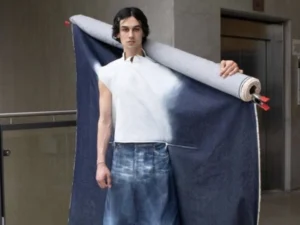Creating black denim is a fascinating process that combines traditional denim manufacturing techniques with specialized dyeing methods. a black fashion textile has emerged, which can add a touch of refinement to any clothing.
In this article, we dive into the steps involved in creating black denim fabric, from choosing the right material to achieving the perfect black shade. So, let’s start to talk about bellowing:
- What is black denim fabric and its charm?
- How to make black denim fabric?
- Special Considerations for Black Denim
What Is Black Denim Fabric and Its Charm?
Black denim fabric is a popular and versatile textile that brings a unique appeal to clothing and fashion. It’s essentially a dark variation on traditional denim fabric. Here are some reasons why black denim is so popular and alluring:
- Timeless Style
Black denim has a classic and timeless appeal. It effortlessly exudes an edgy and sleek aesthetic that will elevate any look. Its dark tone can easily match various colors, patterns, and styles, making it a versatile piece for wardrobes.
- Versatile:
Black denim can be worn formally or casually, suitable for many occasions. From casual outings to more formal events, black denim can be styled accordingly, offering flexibility and adaptability. Wear it with a graphic tee for cool, casual styling, or a tailored blazer for sophisticated styling.
- Flattering:
black denim has a slimming effect on the figure due to its darker color. It tends to create a sleek, slim silhouette and provides a flattering fit for all body types. Whether it’s black denim jeans or a black denim jacket, the color of the fabric helps create a slim and stylish look.
- Durability
Like traditional denim fabrics, black denim is known for being strong and durable. It’s designed to withstand everyday wear and tear, making it a solid choice for durable apparel. Black jeans in particular, known for their ability to hold their shape and resist fading, will stay black over time.
- Seasonal
The versatility and dark color of black denim is perfect for all seasons. It can be worn comfortably in both colder and warmer months, providing a year-round fashion solution. It can be paired with a cozy knit and boots on chilly days, or a lighter top and sandals on warmer days.
Overall, black denim is a stylish and versatile option, Its timeless style, versatility, alluring naturalness, durability, and appeal across seasons make it the fabric of choice for many looking for a fashion statement.
How to Make Black Denim Fabric?
Steps of producing black denim fabric
The black denim fabric has a unique appeal in the fashion world and is a sleek, modern alternative to traditional blue denim. However, have you ever wondered how this stylish fabric is made? now, we’ll take you through ten steps to creating black denim fabric. With professionalism and attention to detail, we delve into each step, providing practical examples to deepen your understanding of the complex process from fiber selection to the final packaged product.
- Fiber selection
The production of black denim begins with the careful selection of the type of fiber to be used. Cotton, polyester, or their blends are the most common choices. Cotton is generally favored for its comfort, breathability, and natural appearance. Polyester offers enhanced durability and wrinkle resistance. By mixing these fibers in specific ratios, manufacturers can achieve desired properties, such as increased strength or stretchability.
For example, a Composition of 98% cotton and 2% Spandex is often used to produce black denim with a slight stretch to provide the wearer with a comfortable fit.
- Yarn production
Once the fibers are selected, yarn production begins. Selected fibers go through a spinning process that converts them into yarns with the desired thickness and strength. Depending on the requirements, traditional ring spinning or modern open-end spinning methods are used. Spinning technology can affect the quality of yarn, which in turn affects the quality of fabric.
Example: To create a high-quality black denim fabric with a soft and luxurious hand, long-staple cotton fibers are spun using the modern ring spinning method. This results in yarns with excellent tenacity, reduced pilling, and enhanced dye retention properties.
- Weaving
The third step in the production of black denim fabric is weaving, where the yarns are interwoven on a loom to form the fabric structure. The choice of the loom, such as a shuttle or projectile loom, and the weaving technique employed can affect the strength, appearance, and texture of the fabric.
Example: To give black denim a classic selvage look, shuttle looms are often used. These traditional looms produce a unique edge called selvage, which results in a denser, more durable fabric.
- Preprocessing
The pretreatment of denim is a key step in the pretreatment of fabric dyeing. The process consists of several stages to remove any impurities, oils, or sizing agents present in the fabric. The pre-treatment technology ensures better dye absorption and improves the overall quality of the fabric.
Example: Desizing is a pretreatment process that involves removing starch used in the weaving process. This process enhances the absorbency properties of the fabric, allowing for better dye penetration in later stages.
- Dyeing base color
Denim’s signature blue undertone comes from indigo, a natural or synthetic blue dye. Achieving the desired indigo shade requires specialized dyeing techniques such as rope dyeing or size dyeing. This step lays the foundation for the subsequent black dyeing process.

Example: Rope dyeing is a traditional method that involves passing the fabric through multiple dye vats to achieve a deep, rich indigo shade. This process ensures consistent dye penetration and produces a high-quality blue base color.
- Blackening
After dyeing the cloth with indigo, the next step is to dye it black. Depending on the desired black shade and specific dye properties, various methods such as sulfur dyeing or reactive dyeing are employed.
Example: Sulfur dyeing is often used to obtain deep black shades in denim fabrics. This method involves dipping the indigo-dyed fabric in a bath containing a sulfur-based dye. The fabric absorbs the sulfur dye to create a true black.
- Processing after dyeing
After dyeing the fabric black, the post-dyeing process is carried out to improve color fastness and enhance the overall appearance of the fabric。 Thorough rinsing and washing are essential to remove excess dye and ensure fabric stability.
Example: Using a fixative such as soda ash or salt during the rinse process will help stabilize the black dye, preventing bleeding and fading. In addition, softeners such as urea and vinegar can also be used to enhance the color and softness of the fabric.
- Organize skills
To give the black denim fabric its distinctive character, various finishing techniques are used. These techniques can produce effects such as stonewashed, sandblasted, or distressed, which enhance its texture and visual appeal.
Practical example: Stonewashing involves tumbling black denim with a pumice stone or enzymes, resulting in a worn and slightly faded look. This technique is widely used to achieve a vintage look while maintaining the black color of the fabric.
- Quality control
Extensive quality control measures are implemented to ensure that the black denim fabric meets quality standards. Tests are conducted to assess aspects such as color fastness, durability, and overall fabric quality.
Practical example: A color fastness test is performed to determine how well the black dye adheres to the fabric. This involves subjecting the fabric to various conditions, such as washing or exposure to light, to assess fading or bleeding. The goal is to ensure that the black denim retains its vibrant color even after repeated use and washing.

Durability testing is another important aspect of quality control. This involves subjecting the fabric to rigorous conditions to assess its strength and abrasion resistance. Testing may include pilling resistance, and rubbing the fabric repeatedly to see if it is pills or pills. Tensile strength tests were also performed to assess how much force the fabric could withstand before breaking.
Assess overall fabric quality by performing a thorough inspection. This includes inspecting the fabric for any defects such as irregularities in texture, weave, or finish. The goal is to ensure that the black denim is free of any blemishes that could affect its appearance or performance.
- Packaging
Once the black denim fabric passes quality control tests, it is neatly folded, packaged, and ready to be distributed or further processed by the garment manufacturer.
Special Considerations for Black Denim
For black denim, there are some special considerations to keep in mind.
The first thing to consider is the possibility of fading. Like any dyed fabric, black denim will gradually fade with time and repeated washing. To help retain the black color, it is recommended to wash black denim in cold water and turn it inside out before washing. Also, using a gentle cycle and mild detergent will help minimize color loss as well.
Another consideration is that black denim tends to attract lint, dust, and pet hair. The dark color of black denim makes these grains more apparent. To solve this, it is recommended to roll up the lint or use a fabric brush to remove debris that may have accumulated on the surface of the fabric. This will help keep your black denim looking clean and fresh.
Black denim is also more likely to bleed or transfer dye to other fabrics or surfaces. To prevent dye transfer, it is very important to wash black denim separately, especially during the first few washes. Adding a color catcher or using a dye-locking product can further help prevent any dye transfer.
Lastly, black denim is more prone to wear and tear than light-color denim. Fading, scuffs and scuff marks will become more noticeable on black fabrics. With this in mind, always handle black denim with care and follow the manufacturer’s washing, drying, and ironing instructions to preserve its appearance and longevity.
By taking these special considerations into account, you can help ensure your black denim looks its best for as long as possible.
Related Link:
ZEVA DENIM has many kinds of black denim, such as 12.7oz Classic Black Stretch Vintage Denim Fabric:8069H with good performance.





